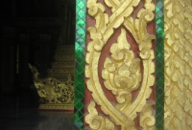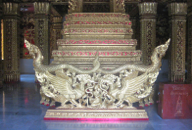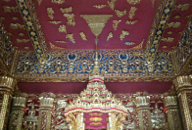Wat ho pha bang
luang prabang Province
Laos, southeast asia
august 9, 2009


Wat ho pha bang
luang prabang Province
Laos, southeast asia
august 9, 2009




The Wat Ho Pha Bang is located within the walls of the Royal Palace in Luang Prabang. As a royal project, it was begun before the monarchy was abolished in 1975. The construction of the temple began in 1993. Though Luang Prabang no longer has a sovereign, this temple is important because it is the future home of the highly revered Buddha figure, the Pha Bang. The statue will eventually be moved from the palace museum to be placed in a vor pra bang, or carved and gilded pagoda, which stands in the center of this structure. In anticipation of this, the construction on the temple continues, with the addition of extremely ornate touches, befitting royalty. Shimmering mirrored mosaics enliven the façade as well as the interior columns, walls and ceiling. Royal palace can be viewed from the portico of the temple. The history of the Pha Bang Buddha is interlaced with the early histories of Cambodia, Thailand and Laos. The Angkor educated prince, Fa Ngum, who established the kingdom of Lang Xang Hom Khao (Million Elephants, White Parasol) c. 1353 with the help of his Khmer sponsors, also introduced Theraveda Buddhism of Cambodia as the state religion. The Khmer king sent a large contingent of monks, and craftsmen to escort a gift, the Pha Bang Buddha image to the Lang Xang; however, it never made it to the capital city. The legend is that the Pha Bang was transported up the Mekong River, but magically refused to be moved and had to be left behind in Viang Chan (present day Vientiane). The reason given was that it sensed that King Fa Ngum was unworthy of receiving this gift. The premonition proved to be correct, as Fa Ngum had begun seducing the daughters of his kingdom’s nobility. The nobles then exiled him to Nam (present day Thailand) where he died within five years. In 1501, the Lao kingdom recovered from its many invasions under King Visoun, who had been governor of Viang Chan. He had been a worshipper of the Pha Bang Buddha image where it had been housed. King Visoun brought this treasure with him from Viang Chan to Xiang Dong Xiang Thong, building the Wat Wisunarat (Wat Visoun) to house it. At that point, the city-state known as Xiang Dong Xiang Thong became known as Luang Prabang (Great Royal City of the Pha Bang).
PHOTOS: Left Column: 1. View of the Royal Palace from the portico of the temple. 2. Façade of Wat Ho Pha Bang, with multi-headed naga staircase. 3. Elegant carved and gilded wooden screen, which shields the altar Wat Ho Pha Bang. 4. Detail: the interior columns of carved and gilded wood inlaid with mirrored mosaics. Center, Top: Detail: Temple window detail, carved and gilded wood on shutters and turned grills. Center, Bottom: The altar of Wat Ho Pha Bang, styled as a Vor Prabang. This is where the revered Pha Bang Buddha will rest, once the temple is completed. Right Column: 1. Exterior view, Wat Ho Pha Bang. 2. Detail: Dragon staircase on Wat Ho Pha Bang. 3. Detail: The ceiling and walls of the main room in the temple, surrounding the altar. These walls have been painted red, with encrustations of sea shell shapes and mirrored mosaics, similar to those in the throne room of the palace. 4. Detail: carved wood and colored mirrored mosaic trim in Wat Ho Pha Bang.


Royal Pavilion






